Experimental Study on the Effects of Heavy Metal Pollution on Soil Physical Properties and Microstructure Evolution
Abstract
1. Introduction
2. Materials and Methods
2.1. Materials
2.2. Preparation of Heavy Metal-Contaminated Soil
2.3. Test Equipment and Scheme
3. Results
3.1. Physical Test Analysis
3.1.1. Study on Particle Gradation of Heavy Metal-Contaminated Soil
3.1.2. Study on Liquid Limit and Plastic Limit of Heavy Metal-Contaminated Soil
3.2. Direct Shear Test Analysis
3.3. Resistivity Test Analysis
3.3.1. Influence of Moisture Content and Pollutant Concentration on Resistivity
3.3.2. The Effect of Porosity on Resistivity
3.4. Experimental Analysis of Microscopic Characteristics
4. Conclusions
- With the increase in heavy metal concentration in contaminated soil, the properties of several soil samples changed. The increase in heavy metal ion concentration leads to the decrease in liquid limit, plastic index, and clay content. This indicates that, to a certain extent, the soil has lost some of its original physical properties, such as fluidity and plasticity, and the content of fine particles in the soil is also reduced.
- According to the results of the resistivity test, it can be observed that the resistivity of heavy metal-contaminated soil shows a complex relationship with water content, porosity, and heavy metal concentration. With the increase in soil moisture content, the resistivity tends to decrease, because the addition of water changes the conductivity characteristics of the soil and makes the resistivity gradually stable. As the porosity increases, the resistivity tends to rise, because more pore space leads to a lengthening of the conductive path, thereby increasing the resistance. With the increase in heavy metal ion concentration, the resistivity drops sharply because heavy metal ions display electrical conductivity in soil.
- Before and after soil is polluted by heavy metals, its pores, particles, and colloidal morphology will change. The fundamental reason for the change of permeability coefficient before and after pollution is that metal ions change the internal structure of soil, especially the size of pores.
Author Contributions
Funding
Data Availability Statement
Conflicts of Interest
References
- Peng, C.; He, Y.L.; Guo, C.H.; Xiao, X.Y.; Zhang, Y. Characteristics and Risk Assessment of Heavy Metals in Urban Soils of Major Cities in China. Environ. Sci. 2022, 43, 1–10. [Google Scholar]
- Cheng, N.C.; Zheng, Y.J.; He, X.F.; Li, X.F.; Zhang, X.X. Analysis of the Report on the national general survey of soil contamination. J. Agro-Environ. Sci. 2017, 36, 1689–1692. [Google Scholar]
- Wang, J.; Mou, C.; Zhao, H.R.; Ding, J.W. Experimental study on quantitative relationship of heavy-meta-contaminated soils. J. Civ. Environ. Eng. 2020, 42, 30–36. [Google Scholar]
- Coby, W.; Xiang, D.L. Analysis of heavy metal contaminated soils. Pract. Period. Hazard. Toxic Radio-Act. Waste Manag. 2003, 7, 1–27. [Google Scholar]
- Zulfahmi, A.R.; ZuhairiW, Y.; Ralhan, M.T.; Sahibin, A.R.; Razi, I.; Tukimat, L.; Syakireen, Z.; Noorulakma, A. Influence of amang (tin tailing) on geotechnical properties of clay soil. Sains Malays. 2012, 41, 303–312. [Google Scholar]
- Liu, G.; Yang, X.J.; Fan, H.H.; Shi, X.; Li, P. Effects of heavy metal ions on physical-chemical and engineering properties of loess. J. Northwest A F Univ. (Nat. Sci. Ed.) 2017, 45, 213–218. [Google Scholar]
- Souli, H.; Fleureau, M.; Ayadi, T.M.; Besnard, M. Physicochemical analysis of permeability changes in the presence of zinc. Geoderma 2008, 145, 1–7. [Google Scholar] [CrossRef]
- Jullien, A.; Proust, C.; Forestier, L.L.; Baillif, P. Hydro-chemio-mechanical coupling effects on permeability and swelling behaviour of a Ca smectite soaked by Cu solutions. Appl. Clay Sci. 2002, 21, 143–153. [Google Scholar] [CrossRef]
- Zheng, Y.L.; Zhang, Y.; Wan, D.; Han, S.; Duan, M. Experimental Study on Physical and Mechanical Properties of Expansive Soil Polluted by Heavy Metals. IOP Conf. Ser. Earth Environ. Sci. 2019, 218, 012022. [Google Scholar] [CrossRef]
- Pan, C. Experimental Study on Evaluation of Heavy Metal Contaminated Soil by Thermal Conductivity Method; Southeast University: Nanjing, China, 2019. [Google Scholar]
- Lv, W.H. Experimental Study on the Physical Mechanical Properties of Heavy Metal Contaminated Expansive Soil in Nan Yang; Zhong Yuan University of Technology: Zhengzhou, China, 2018. [Google Scholar]
- Cheng, R.G.; Ma, F.R.; Pang, Y.B. Experimental analysis of the strength properties of the heavy metal contaminated soil. J. Civ. Archit. Environ. Eng. 2014, 36, 94–98. [Google Scholar]
- Li, L.H.; Yue, Y.W.; Xiao, H.L.; Li, W.T.; Han, Q.P. Performance and influence mechanism of Cd-contaminated soil solidified by rice husk ash-cement. Chin. J. Geotech. Eng. 2023, 45, 252–261. [Google Scholar]
- GB/T 50123-1999; National Standard of the People’s Republic of China. Standard for Geotechnical Test Methods. Ministry of Water Resources of the People’s Republic of China: Bejing, China, 1999.
- Xia, L. Engineering Properties of Heavy Metal Contaminated Soil; Hefei University of Technology: Hefei, China, 2014. [Google Scholar]
- Morvan, M.; Espinat, D.; Lambard, J.; Zemb, T. Ultrasmall-and small-angle X-ray scattering of smectite clay suspensions. Colloids Surf. A Physicochem. Eng. Asp. 1994, 82, 193–203. [Google Scholar] [CrossRef]
- Li, J.S.; Xue, Q.; Wang, P.; Li, Z.Z. Effect of lead (II) on the mechanical behavior and microstructure development of a Chinese clay. Appl. Clay Sci. 2015, 105, 192–199. [Google Scholar] [CrossRef]
- Shariatmadari, N.; Salami, M.; Karimpour, F.M. Effect of inorganic salt solutions on some geotechnical properties of soil-bentonite mixtures as barriers. Int. J. Civ. Eng. 2011, 9, 103–110. [Google Scholar]
- Sunil, B.; Shrihari, S.; Nayak, S. Shear strength characteristics and chemical characteristics of leachate-contaminated lateritic soil. Eng. Geol. 2009, 106, 20–25. [Google Scholar] [CrossRef]
- Wen, B.P.; He, L. Influence of lixiviation by irrigation water on residual shear strength of weathered red mudstone in Northwest China: Implication for its role in landslides’ reactivation. Eng. Geol. 2012, 151, 56–63. [Google Scholar] [CrossRef]
- Tiwari, B.; Tuladhar, G.R.; Marui, H. Variation in residual shear strength of the soil with the salinity of pore fluid. J. Geotech. Geoenviron. Eng. 2005, 131, 1445–1456. [Google Scholar] [CrossRef]
- Jiang, J.F.; Yu, C.; Liao, R.P.; Zhu, C.P. Tests on electrical resistivity characteristics of Wenzhou soft clay with Cu2+. J. Civ. Archit. Environ. Eng. 2018, 40, 85–90. [Google Scholar]
- Sun, Y.K.; Liu, Y.Q.; Neng, C.X.; Dong, L. Development of Resistivity Method in the Investigation of Contaminated Soils. Environ. Sci. Technol. 2011, 34 (Suppl. S2), 165–171. [Google Scholar]
- Zhang, Z.H.; Li, H.Y.; Shi, Y.M. Experimental study on permeability properties and micro-structure of clay contaminated by Cu2+. China Civ. Eng. J. 2014, 47, 122–129. [Google Scholar]
- Liu, Z.B.; Fang, W.; Cheng, Z.L.; Yu, C. Experimental study of influence of zinc ions on one-dimensional compressibility of bentonite. Rock Soil Mech. 2013, 34, 2211–2217. [Google Scholar]
- Liu, G.; Zhang, C.C. Experimental study on the microscopic properties of cadmium-contaminated kaolin clay. Sci. Technol. Eng. 2016, 16, 254–258. [Google Scholar]
- He, Y.Y.; Chen, J.H. Effect cadmium contamination on the mechanical properties and mechanism analysis of the soil. Sci. Technol. Eng. 2019, 19, 276–280. [Google Scholar]
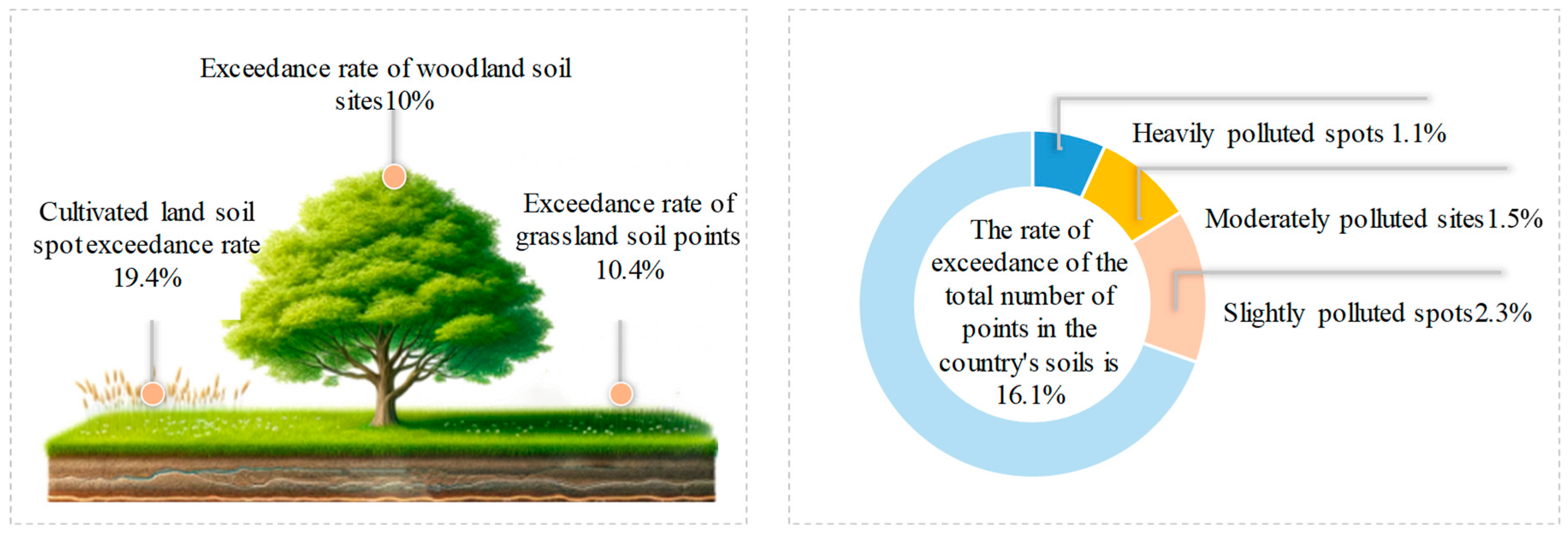
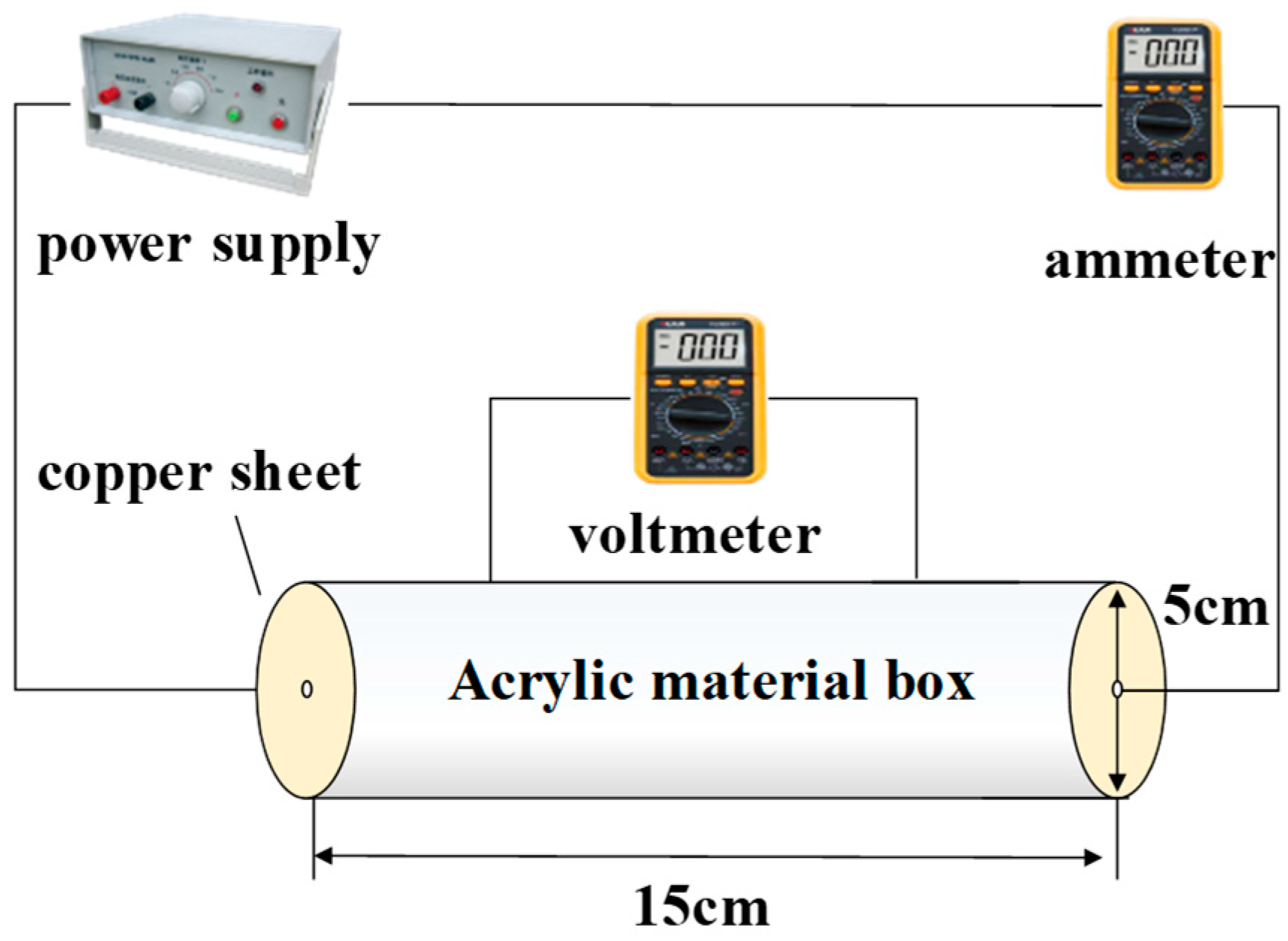
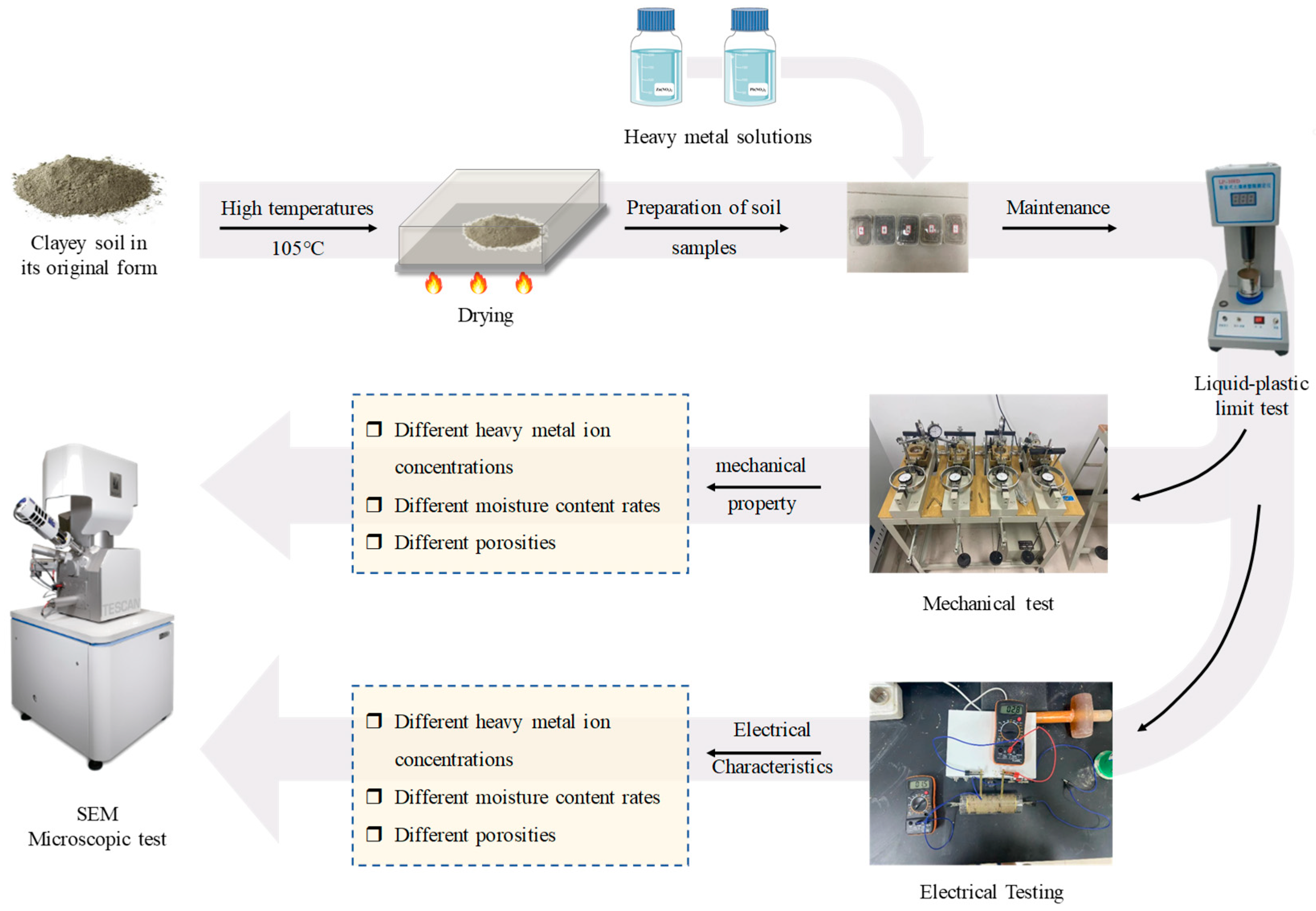
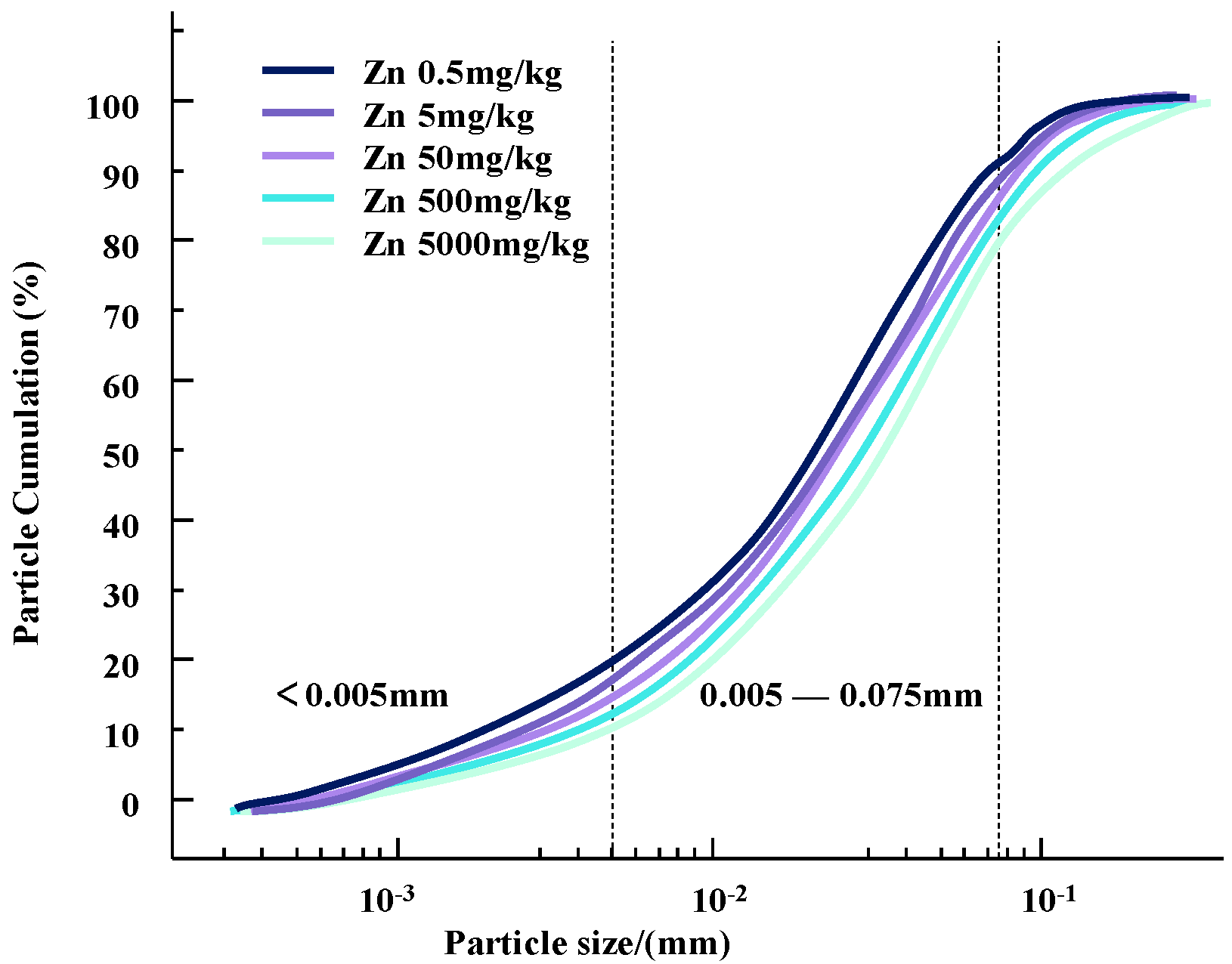
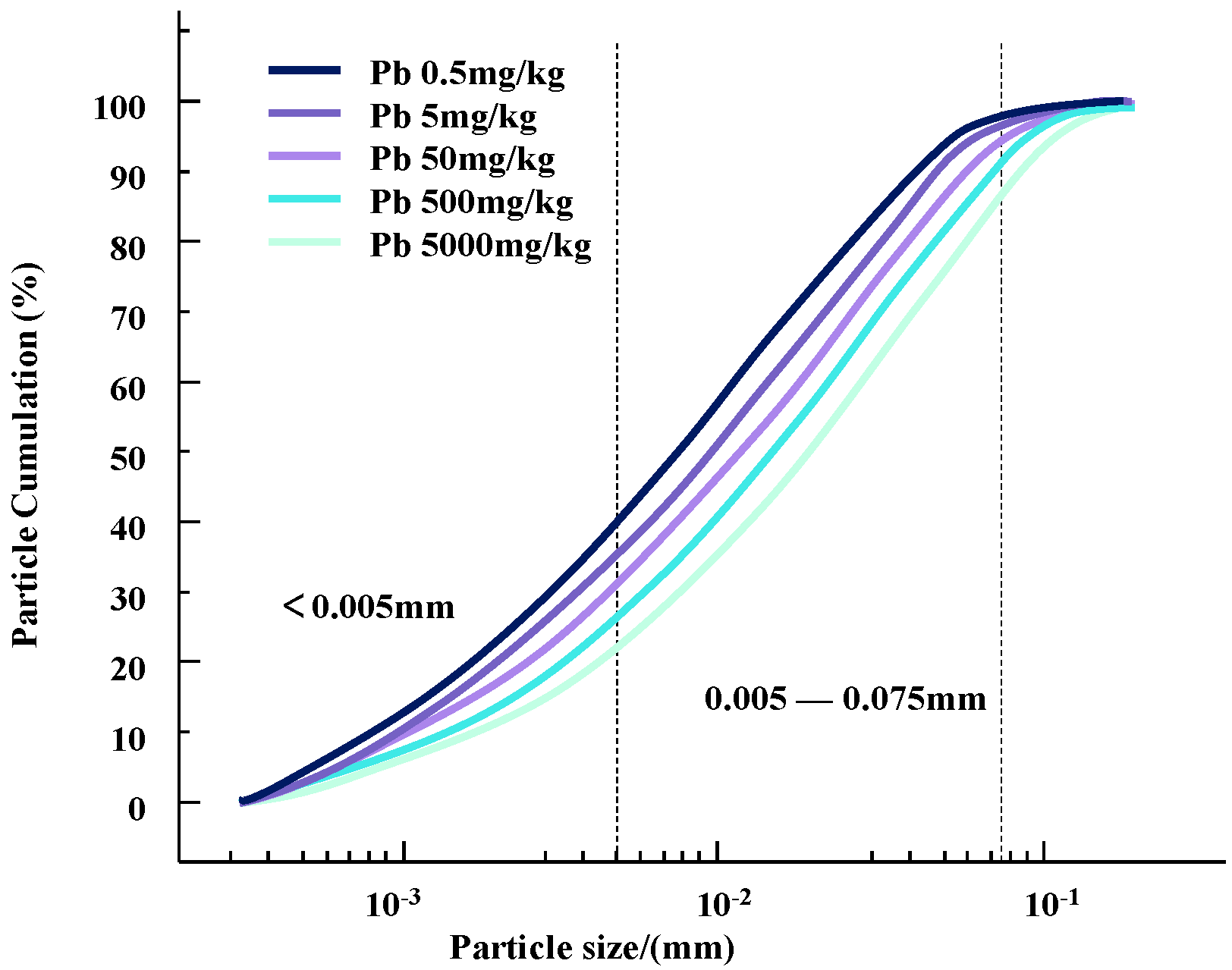
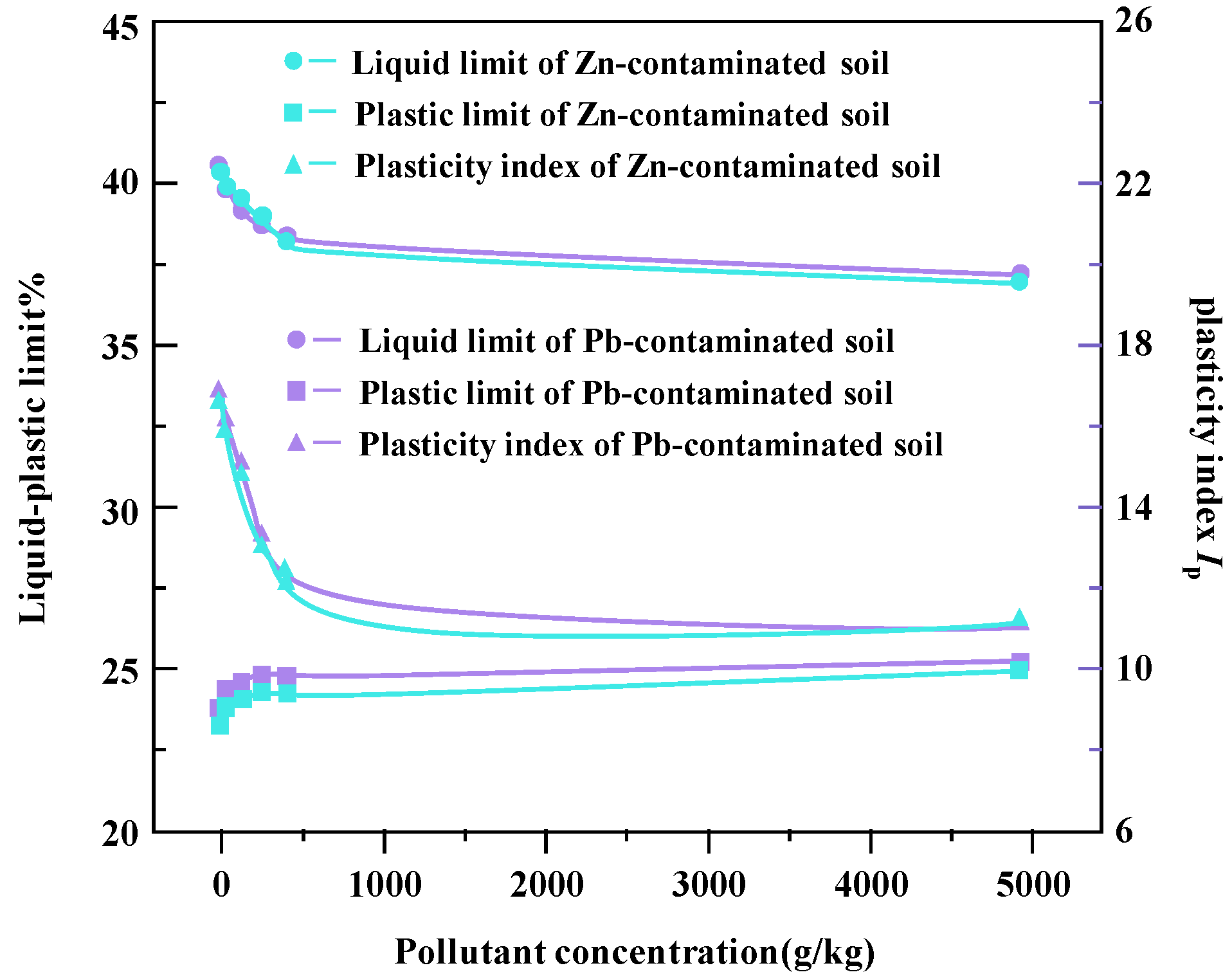
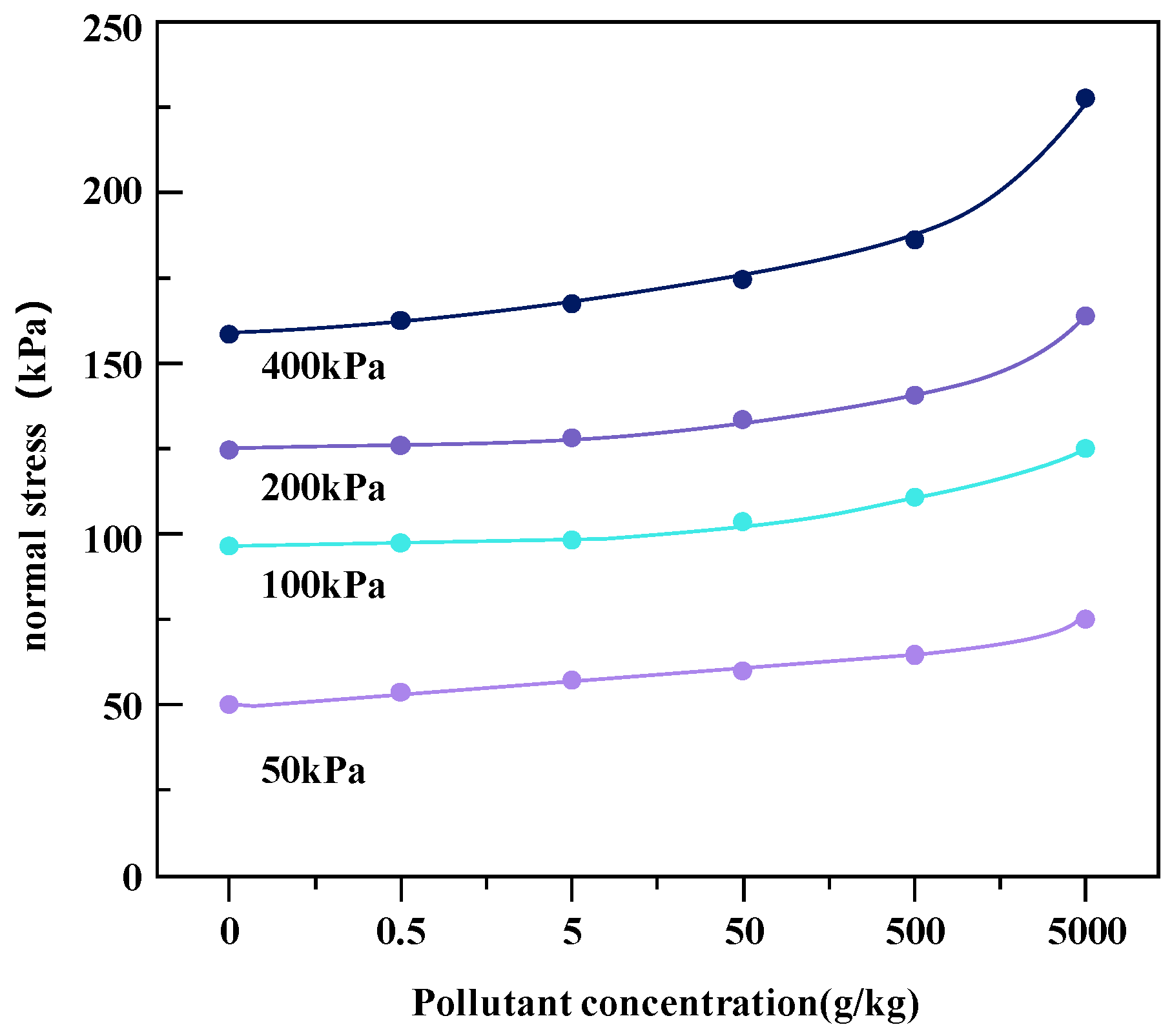
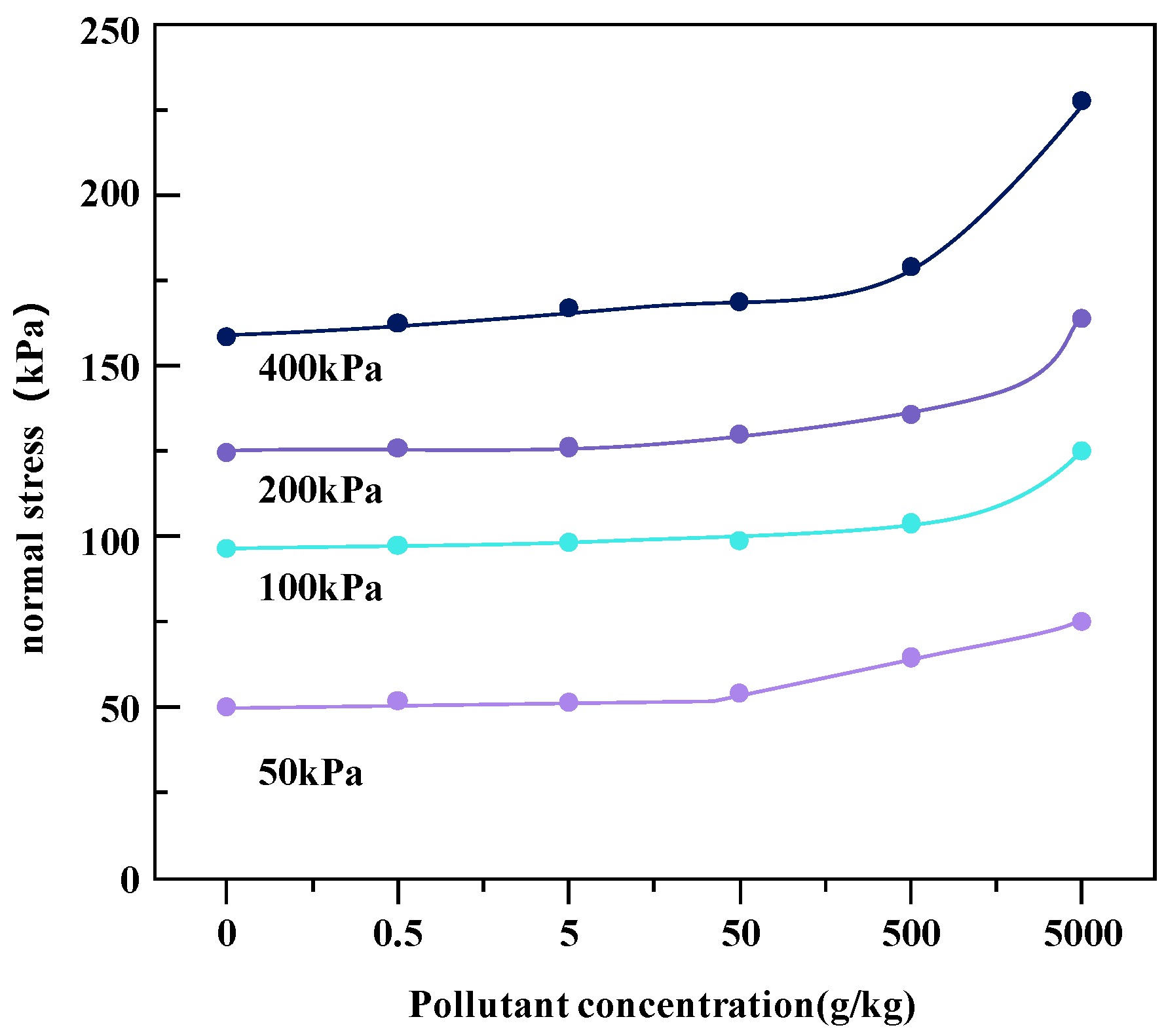

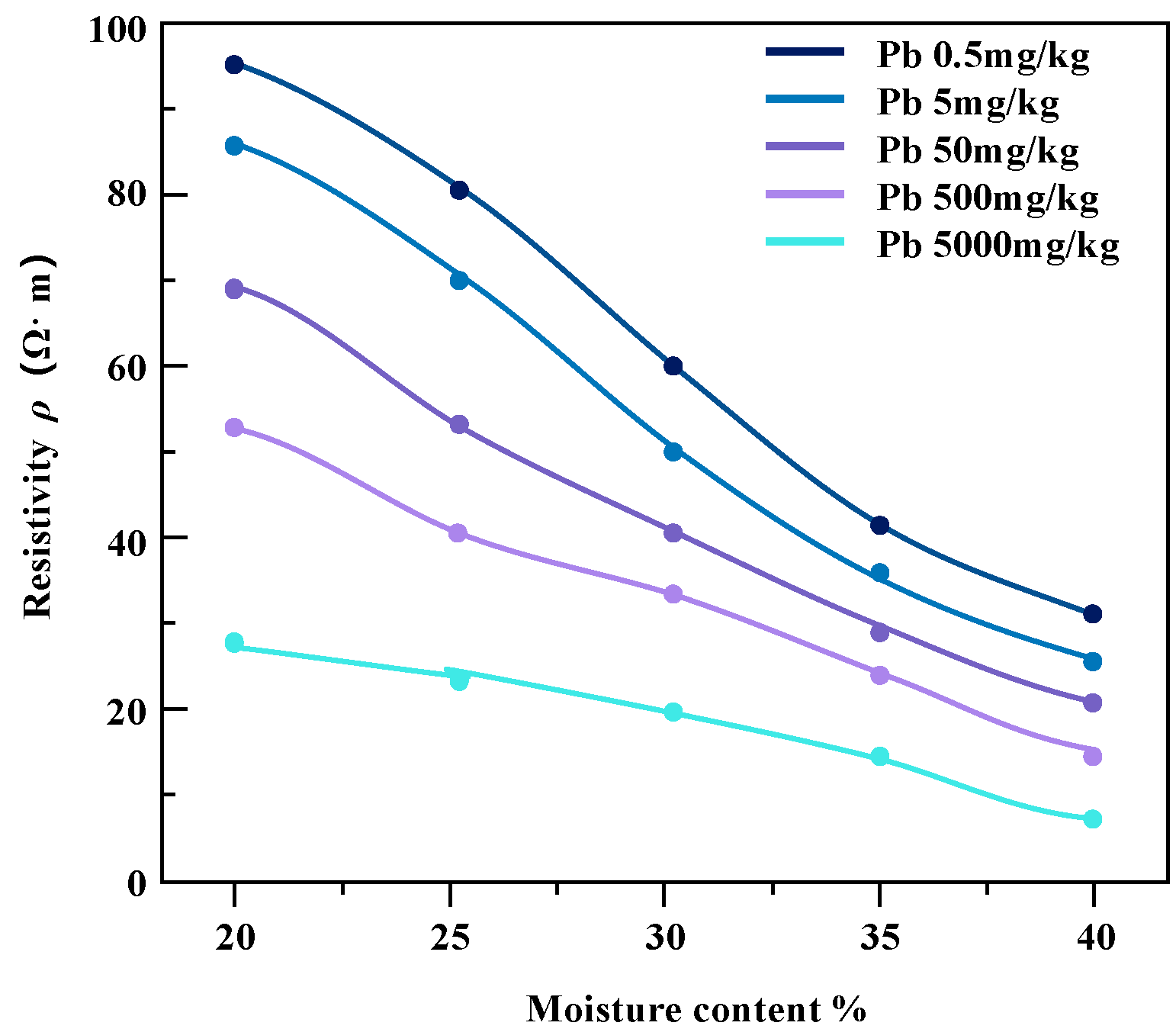



| Parameters | Values |
|---|---|
| Density (ρ) | 2.56 g/cm3 |
| Specific gravity (Gs) | 2.54 |
| Liquid limit (wL) | 41.18% |
| Plastic limit (wP) | 23.9% |
| Plasticity index (Ip) | 17.28 |
| Saturation weight (γs) | 16.1 kN/m3 |
| Atomic Number | Atomic Mass | Ion Valence State | Atomic Radius | Ion | |
|---|---|---|---|---|---|
| zinc | 30 | 65.4 | +2 | 1.39 | 0.60 |
| lead | 82 | 207.2 | +2 | 1.37 | 0.64 |
| Test Content | Sample Parameter | ||
|---|---|---|---|
| Electrical test | Ion concentration | Moisture content | Porosity |
| 0–5000 mg/kg | 20–40% | 0.4–0.5 | |
| Direct shear test | Ion concentration | Moisture content | Porosity |
| 0–5000 mg/kg | 20–40% | 0.4–0.5 | |
Disclaimer/Publisher’s Note: The statements, opinions and data contained in all publications are solely those of the individual author(s) and contributor(s) and not of MDPI and/or the editor(s). MDPI and/or the editor(s) disclaim responsibility for any injury to people or property resulting from any ideas, methods, instructions or products referred to in the content. |
© 2024 by the authors. Licensee MDPI, Basel, Switzerland. This article is an open access article distributed under the terms and conditions of the Creative Commons Attribution (CC BY) license (https://creativecommons.org/licenses/by/4.0/).
Share and Cite
Zhang, G.; Liu, T.; Li, H.; Wang, Z.; Huang, X.; Yi, X.; Yan, D. Experimental Study on the Effects of Heavy Metal Pollution on Soil Physical Properties and Microstructure Evolution. Appl. Sci. 2024, 14, 2022. https://doi.org/10.3390/app14052022
Zhang G, Liu T, Li H, Wang Z, Huang X, Yi X, Yan D. Experimental Study on the Effects of Heavy Metal Pollution on Soil Physical Properties and Microstructure Evolution. Applied Sciences. 2024; 14(5):2022. https://doi.org/10.3390/app14052022
Chicago/Turabian StyleZhang, Guoliang, Tao Liu, Haifeng Li, Zimou Wang, Xixi Huang, Xiangyang Yi, and Dong Yan. 2024. "Experimental Study on the Effects of Heavy Metal Pollution on Soil Physical Properties and Microstructure Evolution" Applied Sciences 14, no. 5: 2022. https://doi.org/10.3390/app14052022
APA StyleZhang, G., Liu, T., Li, H., Wang, Z., Huang, X., Yi, X., & Yan, D. (2024). Experimental Study on the Effects of Heavy Metal Pollution on Soil Physical Properties and Microstructure Evolution. Applied Sciences, 14(5), 2022. https://doi.org/10.3390/app14052022





